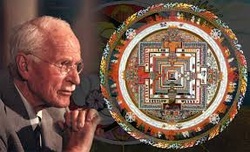 We don’t often think of Carl Jung as a pioneer in the early integration of Eastern thought, beliefs, stories, and mythologies into the Western intellectual world. While Jung has gained notoriety for his deep knowledge of Western mystical traditions such as Gnosticism and Kabbala, it is less well known that he wrote works relating to Buddhism, Hinduism, and Taoism. In 1929, Jung wrote a psychological commentary in the German edition of an ancient Taoist text, “The Secret of the Golden Flower,” translated from the Chinese by Richard Wilhelm. The work appeared a few years later in English: "The relation of the West to Eastern thought is a highly paradoxical and confusing one. On the one side, as Jung points out, the East creeps in among us by the back door of the unconscious, and strongly influences us in perverted forms, and on the other we repel it with violent prejudice as concerned with a fine-spun metaphysics that is poisonous to the scientific mind. A partial realization of what is going on in this direction, together with the Westerner's native ignorance and mistrust of the world of inner experience, build up the prejudice against the reality of Eastern wisdom. When the wisdom of the Chinese is laid before a Westerner, he is very likely to ask with a skeptical lift of the brows why such profound wisdom did not save China from its present horrors. … Through the combined efforts of Wilhelm and Jung we have for the first time a way of understanding and appreciating Eastern wisdom which satisfies all sides of our minds. It has been taken out of metaphysics and placed in psychological experience. … this book not only gives us a new approach to the East, it also strengthens the point of view evolving in the West with respect to the psyche. … In the commentary [Jung] has shown the profound psychological development resulting from the right relationship to the forces within the psyche" (Translator‘s Preface, by Cary F. Baynes, p. vii-ix, Kegan Paul, Trench, Trubner & Co. (London): 1931). Jung’s ideas on Eastern thought catapulted themselves into the very heart of Western academia, perhaps even leading to an invitation by Yale University in 1937 to deliver the famous Terry Lectures “Lectures on Religion in the Light of Science and Philosophy.” Yale also honored Jung with an honorary doctorate. In my opinion, Jung would go further than any intellectual before him to integrate ideas triggered by Eastern thought-motifs into his works, which were primarily intended for Westerners. The collision of Jung and East brought him beyond writing with a focus only of an individual or personal conception of the personality. Jung conceived of a collective unconscious – a reservoir of human experience that occurs semper ubique, Latin for “always and everywhere” meaning that recorded history documents similar experiences in all time eras in across the globe. Jung’s interest in Eastern thought appears vividly in his investigation of the mandala, one of the sacred symbols in Buddhism and throughout the East. Mandala means a “circle,” more especially a magic circle. Mandalas appear in the West during the early Middle Ages of the Christian era. Jung’s psychological innovation was identifying the mandala with an activation of the self, what he calls the center of the entire personality, as distinguished from the ego, which is the center of consciousness. For more on Jung and East, read four articles that we are posting until the end of March, 2013. After that time, they will be available for reading in our Library.
0 Comments
|
On Smartphones, click on the above form and enter your blog in the "COMMENT" section.
Archives
June 2014
CategoriesAll Child Psychology Consciousness Development Dreams Ego Fixation Freud Fromm Hillman Hyperactivity Incest Individuation Intellect Jung Books Articles Mandala Self Spirit Taoism The Four Functions Unconscious Visions Seminar Word Association Test Working With Images |
 RSS Feed
RSS Feed
